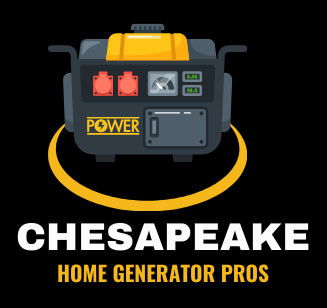
Standby Whole House Generators in Millville VA
Standby whole house generators are designed to provide backup power to your entire home when the main power supply fails. Unlike portable generators, these systems are permanently installed and connected to your home's electrical system, ensuring seamless operation during outages. Their primary role is to ensure that essential appliances and systems—such as heating and cooling, refrigeration, and lighting—remain functional, thereby maintaining comfort and safety.
How It Differs from Portable Generators
While both standby whole house and portable generators serve to provide backup power, they differ significantly:
- Capacity: Whole house generators are designed to power the entire home, whereas portable generators typically provide power for only essential appliances or areas.
- Installation: Whole house generators are permanently installed and integrated into your home’s electrical system. Portable generators require manual setup and are usually connected via extension cords.
- Operation: Whole house generators start automatically and operate with minimal intervention. Portable generators need to be started manually and require regular monitoring and refueling.
How It Works
A standby whole house generator works by continuously monitoring the electrical supply from the utility company. When it detects a power outage, it automatically activates and switches your home’s power source from the grid to the generator. The generator then produces electricity through its engine and delivers it to your home’s electrical system. Once the main power is restored, the generator shuts down and the transfer switch returns power back to the grid.

We will get back to you as soon as possible.
Please try again later.
Types of Standby Whole House Generators
Standby whole house generators come in various types to meet different needs:
- Standby Generators: These are permanently installed and automatically start when a power outage occurs. They are connected to the home’s electrical system and run on either natural gas or propane.
- Automatic Transfer Switch Generators: These include an automatic transfer switch that detects power loss and switches to generator power without manual intervention.
- Dual-Fuel Generators: These versatile units can operate on both natural gas and propane, offering flexibility in fuel choices.
- Diesel Generators: Known for their durability and reliability, diesel generators are ideal for larger homes or those requiring high power levels.
Key Features to Consider
When selecting a standby whole house generator, consider the following features:
- Power Output: Choose a generator with sufficient power capacity to handle all critical appliances and systems in your home.
- Fuel Type: Decide between natural gas, propane, or diesel based on availability and preference.
- Automatic Transfer Switch: Ensure the generator includes or is compatible with an automatic transfer switch for seamless operation during outages.
- Noise Level: Consider the generator’s noise output, especially if it will be close to living areas or neighbors.
- Warranty and Support: Look for a generator that comes with a comprehensive warranty and reliable customer support.
Installation Process
The installation of a standby whole house generator involves several key steps:
- Site Assessment: A professional will assess your home to determine the best location for the generator, considering factors like ventilation and accessibility.
- Permits and Regulations: Obtain necessary permits and ensure the installation meets local building codes and regulations.
- Generator Placement: The generator is placed on a concrete or gravel pad, and connections to the fuel source and electrical system are made.
- Testing and Commissioning: After installation, the system is thoroughly tested to ensure it operates correctly and meets your power needs.
Maintenance and Care
Regular maintenance is crucial to ensure the reliable performance of your whole house generator:
- Routine Inspections: Schedule annual inspections to check for any wear or issues.
- Fuel Checks: Monitor fuel levels and ensure the fuel source is clean and functional.
- Battery Maintenance: Check and replace the battery as needed to ensure reliable starting.
- Cleaning: Keep the generator clean and free from debris to prevent overheating and ensure efficient operation.
Initial and Ongoing Costs
The costs associated with a standby whole house generator include:
- Initial Purchase and Installation: This can vary based on the generator’s capacity, fuel type, and installation complexity. Generally, prices range from $5,000 to $15,000.
- Ongoing Costs: Include fuel, maintenance, and any repairs. Regular maintenance and fuel costs are essential to keep the generator in good working condition.
The Importance of Backup Power Solutions
Having a standby whole house generator is crucial for ensuring that your home remains functional during power outages. It provides peace of mind by maintaining essential services like heating, cooling, refrigeration, and lighting. In areas prone to frequent outages or extreme weather, a standby whole house generator is an investment in security and comfort.
What We Offer
We specialize in providing top-quality
standby whole house generators in Millville, VA. Our services include:
- Residential Generators
- Commercial Generators
- Portable Generators
- Electric Generators
- Propane Generators
- Solar Generators
- Generator Repairs
- Generator Maintenance
- Generator Parts
Ensure your home is always prepared for unexpected power outages. Contact us today to learn more about our standby whole house generator solutions and schedule a consultation. Our team is here to help you choose and install the perfect generator to meet your needs. For reliable power solutions and exceptional service, trust us to keep your home running smoothly, no matter what.
Let's Connect!
As power outages become increasingly common, having a reliable backup generator can make all the difference. We specialize in providing top-notch generator installation and maintenance services to keep our customers prepared for anything. Whether you're looking for a whole-house generator or a small portable unit, we have the knowledge and expertise to help you choose the right option for your home and budget. Don't let life's unexpected power outages catch you off guard—hire us today and enjoy peace of mind knowing that your home is protected.